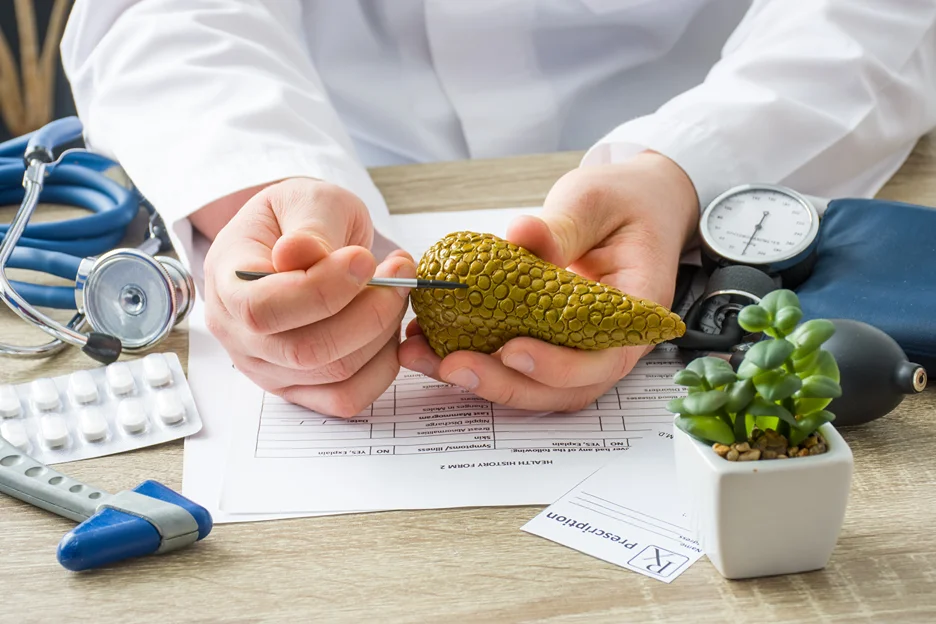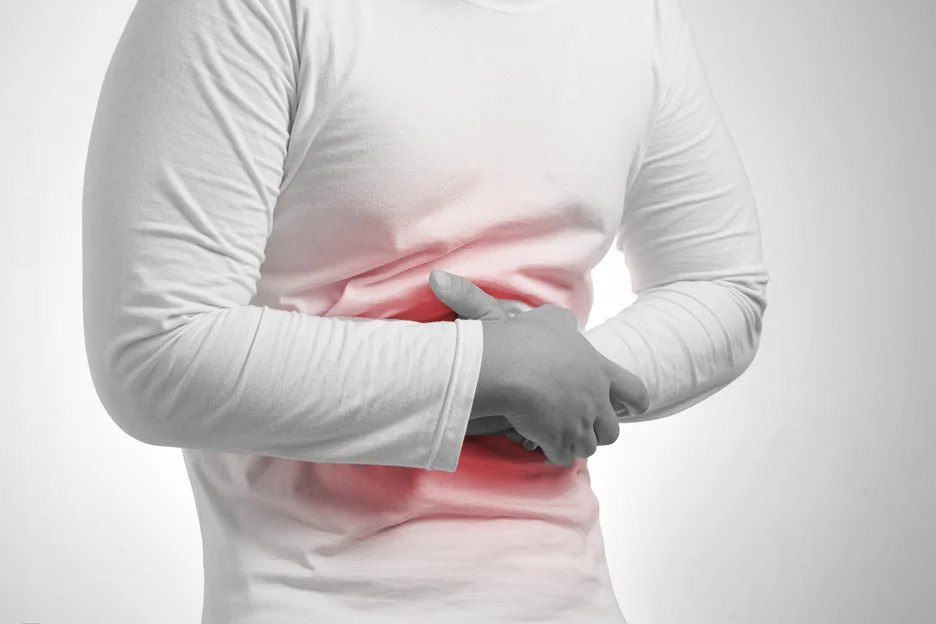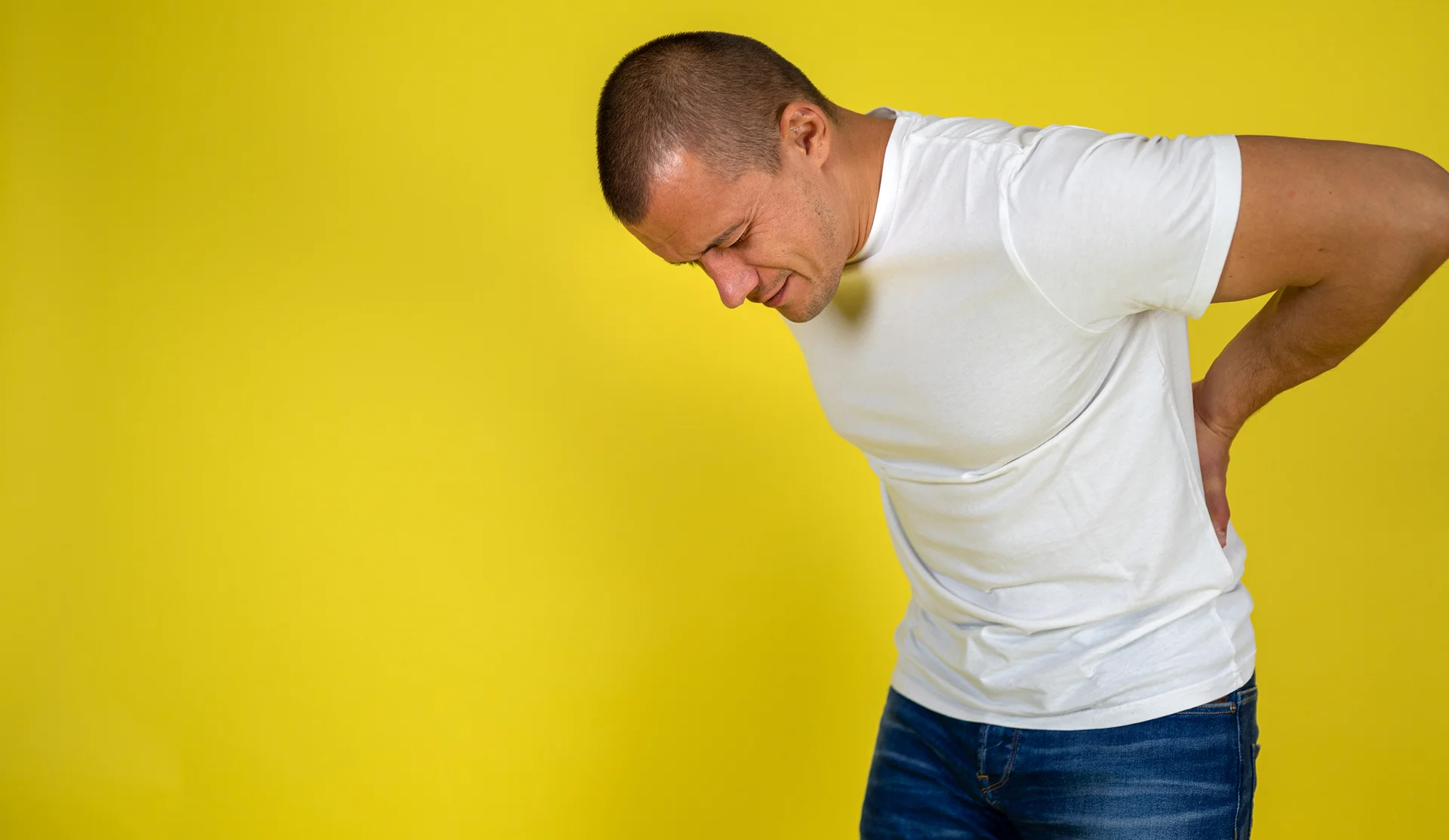Can’t shake your back pain? Pancreatic problems could be the surprising culprit.
Back pain may seem straightforward, but the true source isn’t always the back itself. Surprisingly, stubborn discomfort between your shoulders or deep in your abdomen could arise from an often-overlooked culprit – your pancreas.
Referred pain fools even doctors, but learning the subtle clues can reveal if this organ is actually causing your misery. Kaly’s specialists will pinpoint all these clues for you in the following post.
Can the Pancreas Cause Back Pain?

Yes, the pancreas can cause back pain through referred pain, which happens when inflammation or tumors in the pancreas confuse nerve signals, causing pain to be felt in the back rather than the pancreas itself.
At first glance, it seems odd that a problem with the pancreas, tucked away in the upper abdomen, could be felt as back pain. However, this phenomenon occurs due to something called referred pain.
Here’s how it works:
The pancreas shares nerve pathways with the thoracic spine in the upper back region. When the pancreas becomes inflamed, enlarged or irritated, it confuses these nerve signals.
The nerves misinterpret the pain signals coming from the pancreas as originating in the back instead. This is called referred pain – where the pain manifests at a secondary site, even though the true origin is an internal organ like the pancreas.
Want clarity on what’s causing your back pain? Consult Kaly specialists to leave no stone unturned.
How to Tell if Back Pain is From the Pancreas?
Pancreatic back pain Qhas distinguishing features like upper abdominal/back location, constant dull pain worse at night, pain that radiates to the back, and associated digestive symptoms, which differ from typical muscular low back pain that changes with position/exertion.
Mind the Location
Based on our experience, pancreatic back pain frequently centers in the upper abdomen and wraps around to the upper-middle area of the back. Pain concentrating on the upper left side is also common. This contrasts with lower back pain from muscular causes.
Look at the Nature of Pain
The pain is often described as dull, boring, and constant, rather than coming and going. Some characterize it as feeling like a tight band squeezing around their midsection. The severity may fluctuate but it is generally unrelenting.
Does It Feel Worse at Night?
Lying flat on the back often exacerbates pancreatic pain, while sitting upright or leaning forward can provide slight relief. This distinguishes it from musculoskeletal back pain.
Understand the Relationship to Eating
The pain may intensify after consuming a meal, especially one high in fat. Pain arising 1-2 hours after eating is another clue according to our patients’ experience.
Does It Radiate?
Pancreatic back pain frequently starts in the upper abdomen and radiates around to the mid-back. In some cases, the back pain is actually more severe than the abdominal discomfort.
Take Note of Associated Symptoms
Other digestive complaints like abdominal bloating, nausea, diarrhea, unexplained weight loss, or greasy stools frequently accompany pancreatic back pain.
Unlike regular back strain, pancreatic pain persists through position changes, is not affected by exertion, and is not muscular in nature. Constant pain that disturbs sleep warrants suspicion of a pancreatic cause.
How Does Pancreatic Back Pain Differ from Regular Back Pain?
Pancreatic pain feels dull, persists at night, worsens with eating, and has associated digestive symptoms, while regular back pain is affected by position changes, worsened by exertion, localized to the lower back, and caused by muscular/joint issues.
Take the time to view this comparison to learn more about the distinguishing factors of these two types of back pain:
| Feature | Pancreatic Back Pain | Regular Back Pain |
| Location | Upper middle back or left upper back | Lower back |
| Nature of Pain | Dull, boring, constant | Intermittent, comes and goes |
| Relationship to Position | Not affected by position changes | Changes with position |
| Relationship to Motion | Not affected by exertion or strain | Can be worse with movement |
| Nature of Pain | Tight, squeezing, band-like | Muscular, joint pain |
| Time of Day | Typically worse at night | Varies |
| Associated Symptoms | Nausea, vomiting, weight loss, etc. | None |
| Potential Causes | Pancreatitis, pancreatic cancer | Muscle strain, arthritis, injury |
| Risk Factors | Alcohol use, family history | Overuse, old injury |
| Diagnostic Tests | CT scan, MRI, blood work | X-ray, muscle palpation |
| Treatments | Treat underlying pancreatic condition | Rest, pain medications, physical therapy |
Can Location of Back Pain Indicate Location of Pancreatic Tumor?
While back pain location may suggest the general region of a pancreatic tumor, like upper back pain indicating a body/tail tumor, relying on pain patterns alone is not enough – confirmatory imaging with CT/MRI scans is essential for accurately diagnosing tumor location.
Pancreatic tumors can irritate nerves and organs around the pancreas, eliciting referred back pain.
Tumors on the body/tail of the pancreas more frequently cause back pain than tumors on the head. This is because body/tail tumors grow larger before producing symptoms, enabling them to press on surrounding structures.
The pain manifests as a dull, aching discomfort concentrated in the mid or upper back. Some describe it as starting in the upper abdomen and radiating around to the back.
While the site of back pain may suggest the general region of the tumor, imaging tests like CT or MRI scans are needed to definitively determine a tumor’s location and size. Relying solely on pain location is not adequate.
Can Pancreatitis Cause Back Pain?

Yes, pancreatitis frequently causes upper abdominal and mid and upper back pain because inflammation and swelling of the pancreas can irritate surrounding nerves like the splenic nerve, provoking referred back pain, especially in acute cases; this pain often worsens when lying down and improves when leaning forward.
The pancreas sits behind the stomach. When inflamed, it can put pressure on or irritate surrounding nerves like the splenic nerve. This nerve runs along the pancreas and spleen, and its irritation provokes referred pain to the left shoulder blade and mid-back.
Repeated bouts of inflammation from chronic pancreatitis also damage pancreatic nerves over time, eliciting upper back pain between the shoulder blades based on our experience.
The typical pain patterns include:
- Acute pancreatitis causing sudden, severe abdominal pain radiating straight through to the back
- Chronic pancreatitis causing a recurrent dull upper abdominal ache that wraps around to the back, either constant or intermittent
- Worsening of pain when lying flat on the back
- Relief from leaning forward or curling up
- Pain triggered or exacerbated after eating, especially fatty foods
What Other Symptoms are Common with Back Pain in Pancreatitis?
- Nausea and vomiting – Irritation of the pancreas often spreads to the stomach, causing severe nausea/vomiting.
- Abdominal bloating – Inflammation and fluid buildup in the abdomen leads to bloating and distension.
- Fever – Low grade fevers frequently occur due to the inflammatory response, while high fevers over 102°F indicate severe disease.
- Fatigue – The inflammation and metabolic effects of pancreatitis typically cause pronounced fatigue.
- Weight loss – Poor intake from nausea/vomiting and malabsorption from loss of pancreatic function can result in weight loss.
- Clay-colored stools – Bile flow obstruction decreases bile output, resulting in abnormal light-colored stools.
- Jaundice – Blocked bile ducts prevent bile release, leading to yellowed skin and eyes.
- Diarrhea – Chronic pancreatitis can cause fatty, oily stools (steatorrhea) from inability to properly digest fats.
- Diabetes – Damage to insulin-producing cells may provoke diabetes in chronic pancreatitis.
Is Back Pain a Symptom of Pancreatic Cancer?
While dull, aching upper abdominal or mid/upper back pain can signify pancreatic cancer if caused by tumors pressing on surrounding nerves, most back pain has other common causes like muscle strain; still, unexplained persistent back pain warrants medical evaluation to determine if testing is needed.
Back pain, especially in the upper abdominal or mid/upper back regions, can arise as a symptom of pancreatic cancer in some cases. The pain is often described as dull aching according to our patient’s report.
It may worsen after consuming a meal or when lying down flat on the back. This back pain is typically caused by a pancreatic tumor pressing on and irritating nearby spinal nerves or organs located behind the pancreas.
Vague, Nonspecific Symptoms
Pancreatic cancer often progresses without any overt symptoms until later stages. When symptoms do begin appearing, they can be quite vague and mimic many other conditions.
Back pain may be one of the first noticeable symptoms, but is not definitively diagnostic for pancreatic cancer on its own.
Other Associated Symptoms
Some other symptoms that may arise in conjunction with back pain due to pancreatic cancer include:
- Jaundice (yellowing skin and eyes)
- Unexplained weight loss
- Loss of appetite
- Nausea
- Changes in stool consistency
- New onset diabetes
When to Seek Evaluation
Any unexplained, persistent symptoms warrant medical evaluation. However, back pain alone is not enough to assume pancreatic cancer.
Doctors from Kaly can determine if any diagnostic testing is recommended based on a full assessment of symptoms, risk factors, and health history. Partner with one now!
Differences Between Back Pain from Pancreatitis and Pancreatic Cancer
Differences between back pain from pancreatitis and pancreatic cancer include pancreatitis pain starting suddenly, worsening with eating, and fluctuating in severity versus cancer pain being a dull constant ache that worsens over time; also over 80% get abdominal pain with pancreatitis while cancer pain is less common.
Back Pain from Pancreatitis
- Typically begins suddenly as severe, sharp, or burning pain in the upper abdomen that radiates to the back
- Often worsens after eating, especially fatty foods
- Leaning forward brings relief, lying flat makes it worse
- Pain episodes in chronic pancreatitis last hours or days and become more frequent over time
- Over 80% of chronic pancreatitis patients experience abdominal pain, often severe, according to this study
Back Pain from Pancreatic Cancer
- Begins as a dull ache in the upper abdomen spreading to the mid or upper back
- May be intermittent at first but becomes more constant as cancer advances
- Up to 80% with advanced cancer have back pain, but early-stage tumors may not cause pain
- Pain is typically less common and less severe than with chronic pancreatitis
How Is Pancreas-Related Back Pain Usually Treated?

Treatment involves lifestyle changes like avoiding alcohol/smoking, medications like analgesics/enzymes, nerve blocks for numbness, endoscopic procedures to decompress the pancreas, surgery to remove damaged areas, and collaborating across specialties like pain management and psychology.
Lifestyle Changes
The first line of treatment involves lifestyle modifications to rest the pancreas and prevent further damage:
- Completely avoiding alcohol, as it worsens inflammation and damage
- Quitting smoking, which accelerates pancreas injury
- Switching to a low-fat diet to reduce demands on the pancreas
Medications
If lifestyle changes are inadequate, medications can help manage the pain:
- Over-the-counter analgesics like acetaminophen and NSAIDs (ibuprofen, aspirin)
- Prescription opioids like morphine or codeine for severe pain unresponsive to OTC meds
- Antidepressants like amitriptyline to aid coping and sleep
- Pancreatic enzyme supplements to reduce pain by resting the pancreas
Nerve Blocks
For medication-resistant pain, anesthetic nerve blocks can provide temporary relief:
- Celiac plexus block – anesthetic injected to numb abdominal nerves
- Alcohol injection – alcohol injected to numb pancreatic nerves
Endoscopic or Surgical Procedures
Endoscopic options to decompress the pancreas:
- Pancreatic sphincterotomy
- Stent placement
- Stone/tissue removal
- Surgical options:
- Drainage procedures
- Removing part or all of the damaged pancreas
Multidisciplinary Care
Experts from Kaly emphasize a collaborative approach across specialties like pain management, psychology, and occupational therapy.
Don’t struggle with the back pain mystery alone. Kaly doctors know how to pinpoint hidden causes. Start your search here!
FAQs
Can jaundice and back pain occur together in pancreatic disorders?
Yes, the concurrent jaundice and back pain in pancreatic disorders is often due to a tumor obstructing the bile duct and pressing on the nerves around the pancreas.
Does back pain location change with pancreatic cancer progression?
As pancreatic cancer progresses, back pain may spread from the mid-back to the upper and lower back as the tumor invades surrounding tissues like the spine and abdominal organs.
Can location of back pain indicate stage of pancreatic cancer?
While back pain location alone does not definitively indicate pancreatic cancer stage, mid-back pain early on can suggest localized disease while abdominal and lower back pain often correlates with advanced stage.
Is there a link between back pain severity and stage of pancreatic cancer?
More severe pancreatic cancer back pain is often associated with later stage disease as the tumor grows, spreads beyond the pancreas, and compresses or invades nerves and surrounding structures.
Does severity of pancreas-related back pain change with disease progression?
Yes, pancreas-related back pain typically worsens and becomes more persistent as pancreatic cancer advances, rather than being intermittent early on.
Are there positions or activities that worsen pancreatic disease back pain?
Lying down, sitting up straight, eating, and bending often worsen pancreatic back pain, while leaning forward, lying on one’s side, and hot showers can temporarily relieve pain.
Can pancreatic cancer cause stomach and back pain at the same time?
Yes, pancreatic cancer can concurrently cause abdominal pain from pressing on organs and back pain from invading spine nerves, especially as the tumor grows.
Do men and women feel pancreatic cancer back pain in different locations?
There is no clear evidence that the location of back pain in pancreatic cancer differs significantly between men and women.
Is lower back pain a sign of early-stage pancreatic cancer in women?
No, lower back pain is not a common early symptom of pancreatic cancer in women. While back pain can occur with pancreatic cancer, it more commonly occurs in the later stages of the disease.
